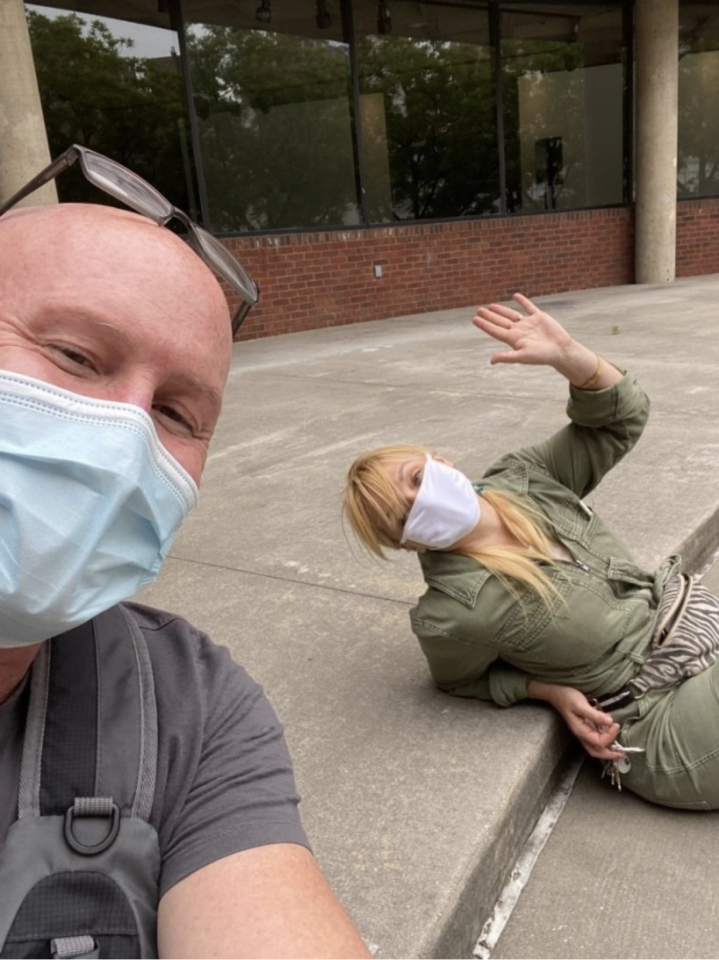
This story was written by Robin Schatell.
Everyday I walk past Abrons Arts Center. I live across the street. I see it out my window. Empty. Quiet. Still. It makes my heart sink seeing it dark. Its gallery walls blank, amphitheater steps silent and doors locked. So I checked in recently, over the phone, with Craig T. Peterson, Artistic Director of the Abrons Arts Center, to see how someone used to overseeing a vibrant cultural space that offers performance presentations, exhibitions, education programs, and residencies, is managing this time of quarantine.
I came away from our conversation with a longing for community. Togetherness. That feeling that comes from the collective sharing of values, or place, or an experience. In Abrons’ case, this means gathering together in a theater, or auditorium, gallery, or classroom. It means watching a dance performance, attending an art opening, or taking a guitar lesson.
These days, we all wonder when we will be do this again. We also have started to wonder—we have no choice, really—if togetherness needs to be physical. It’s been close to five months and all the gatherings we have attended have been remote, save for a few outdoor dinners on the street. Can you get the same feelings from a screen? Alone with your screen? It’s funny, our kids have screen time in their DNA. We monitor them, tell them too much screen time is bad. But now, it’s all we’ve got. We’re here with our screens, trying to get as much stimulation as we can, to squeeze out as much human contact that a live projected image will allow.

Craig is most sad about not being able to gather his community. It brings with it an identity crisis. “We have our real estate, our space,” he said. “We have our human capital–our constituents, our artists, our teachers. What are we good for without those?”
All of us in the arts are in an identity crisis. What are we good for? Craig may not know the answer to that, but he knows, as I do, that artists are equipped for crisis. We are flexible, adaptable and used to performing with little support, and even fewer resources. This gave Craig an idea. As he said to me, “they (his Abrons production team) have all the skills needed to organize large groups of people to do complex projects.”
So, with its theater spaces and galleries dark, Craig partnered with Abrons’ parent organization, Henry Street Settlement, and Vision Urbana, a Lower East Side organization, and started a food pantry. Instead of furloughing or laying off his tech and operations staff, he put them to work sourcing, packing and delivering close to 850 meals a week. John Harper, Abrons’ dedicated Director of Operations, returned to the city from the quarantined safety of his family’s home in Virginia, to lead the project.
For Craig, Abrons utilizes its space and community to problem solve. The gatherings are “fundamental to this dance. It’s challenging not to be able to have a place to gather.” But the food pantry has grown into much more—it has become a project that brings not only staff together, but also many local artists–Julie Atlas Muz, Jenny Romaine, Aaron Landsman, Emily Johnson, Flaco Jiminez, among others–who show up every week to help.

During the second week of food delivery, Craig and his education team collected artwork from Abrons children’s classes and put them in the food bags for homebound seniors. One senior colored in her art piece and sent it back. So, Craig, brilliantly, ordered supplies and art kits, adding them to the meal packets. “We’re nourishing people’s souls with art, and their bodies with food,” he said. “At least there’s that.”
Apart from running the food pantry, Abrons’ continues to support artists during COVID-19 in creative new ways. In early April they launched an Artist Community Relief Fund to support local artists and arts workers affected by the pandemic, giving away close to $30,000 in small emergency grants. Ali Rosa-Salas, Director of Programming, has been pushing out all of Abrons’ digital programming since the lock-down. Its monthly AAC Sound Series, a digital platform that features sound-based work by New York City artists, continues through August with “A Language of Intimacy,” presented with Boston Center for the Arts. The work features nine artists exploring the concept of intimacy in light of the social distancing required during this pandemic.
This past Thursday, July 23, Abrons’ brought people together on the steps of its Amphitheater, masked and at a safe, socially distanced six-feet-apart, for a candlelit “Kinstillatory gathering and care and protection procession” to the East River, led by its Social Practice AIRspace Resident Artist Emily Johnson. The mission: “To wield love, provocations, and poetry for healthy and indigenous and Black centered futures, and to honor and give gratitude to the 1,000 trees that will be killed when East River Park is destroyed in September.”
So, Craig figures it out, manages to still use his space, and his human capital, to bring us all together. To keep the art going.
In the time since Craig and I spoke, a very visible addition to his food distribution program has materialized in front of Abrons’ amphitheater– a white community fridge, courtesy of a mutual aid partnership between Abrons and the activist group, In Our Hearts — offering free food for anyone in need. The sign reads: “Take What you need. Leave what you don’t. Comida Gratis.” The fridge was empty when I passed it on this particular afternoon, but I imagined it stocked full of fresh fruit, and sandwiches, juices, produce and cheeses for those who are hungry.
Robin Schatell has been an active NYC arts & culture advocate, producer, manager, and curator for nearly three decades. She lives on Grand Street in Lower Eastside.










